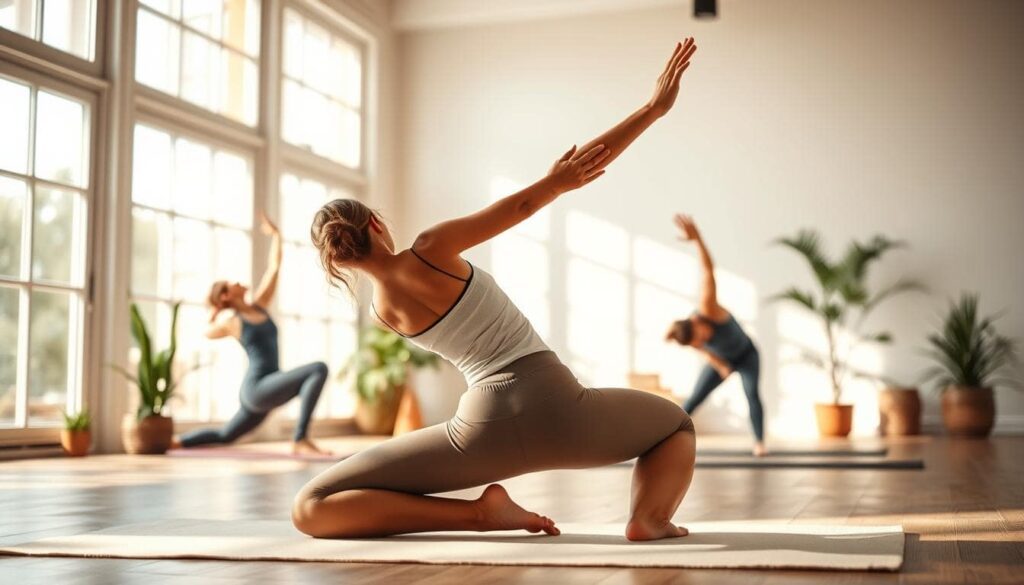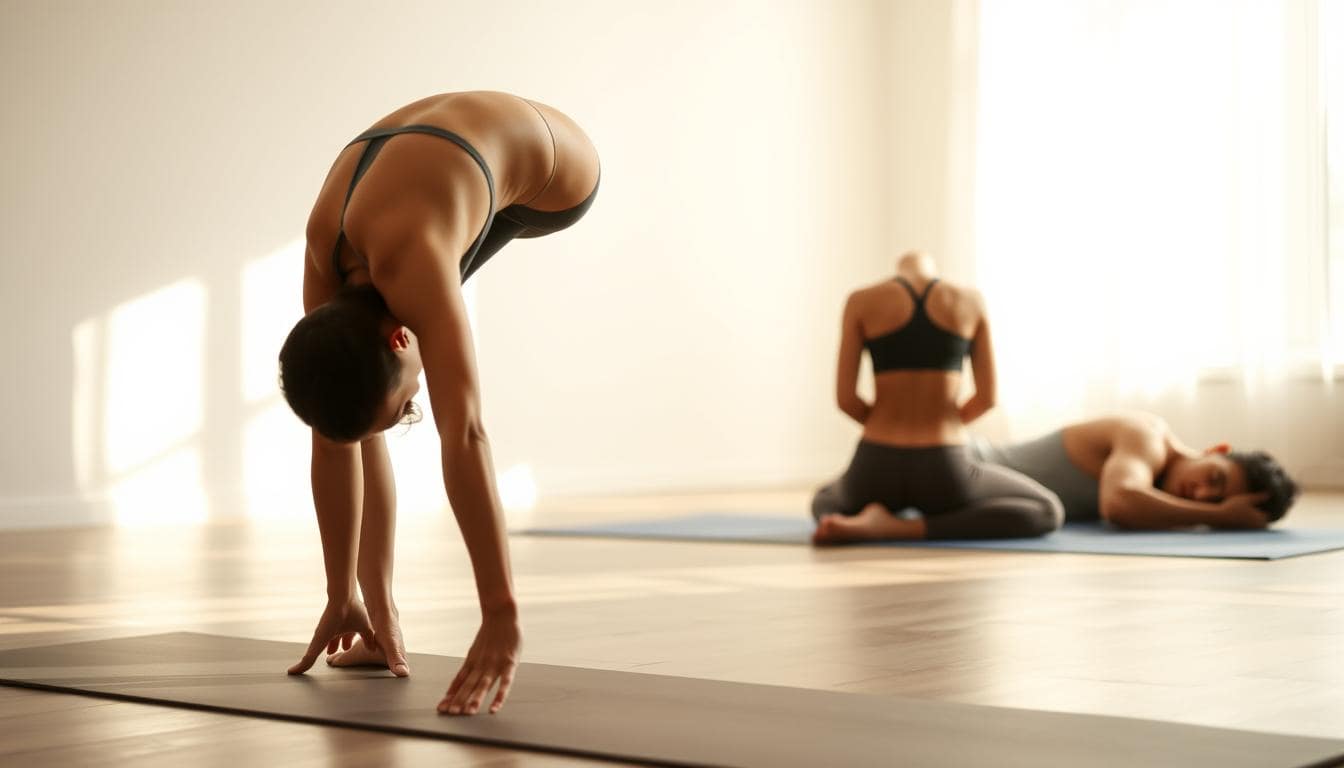Yoga Stretches for Tight Hips and Lower Back Relief The model is set in elegant hosannas such as pigeon pose, lizard pose, and child’s pose in the foreground on a soothing, light-colored mat. The middle plane is filled with potted plants and small indoor pieces of furniture, but the background remains out of focus so that the eye can continue to be on the flowing body motions of the model. The mood is tranquil, conscious, and intellectual and physical rejuvenation.
Learning yoga stretches for the tight hips and lower back discloses numerous advantages. Regular practice will enhance flexibility and ease pain. We’ll discuss yoga stretches and yoga poses reducing hip and lower back pain, demonstrating how easy yoga can be helpful.
Understanding the Connection Between Hip and Lower Back Pain.
The connection between hip and lower back pain is complicated. To experience lower back relief yoga and be relieved, understanding how tight hips influence your back is important. Tight hip muscles may lead to bad posture, which puts stress on your lower back and results in pain. Incorporating hip flexibility exercises in your daily activity can ease tension and enhance mobility.
Poor posture, overuse, and weak core muscles are common culprits behind hip and back tension. Indications that you need to focus on hip flexibility are stiff hips, lower back pain, and difficulty with everyday activities. Catching these indicators and taking action is the beginning of relief and improved health.

To understand the hip and lower back pain link, keep these things in mind:
- Poor posture puts pressure on the lower back, resulting in pain and discomfort.
- Weak core muscles cause bad posture, placing additional stress on hips and lower back.
- Incorporating hip flexibility exercises and lower back relief yoga into your daily routine can relieve tension and improve well-being.
Understanding the hip and lower back pain link is the first step to relief and better health. Make sure to include hip flexibility exercises and lower back relief yoga in your daily life to reduce tension and boost your overall health.
Benefits of Frequent Hip-Opening Yoga Practice
Frequent hip-opening yoga practice has several benefits. It can improve flexibility, relieve pain, and promote general well-being. Through daily practice of yoga poses for back pain and hip stretches, you can witness these benefits for yourself. The exercise loosens tight hip muscles, enhances blood circulation, and minimizes swelling. All these may help in reducing back pain.
Some of the most important advantages of regular hip-opening yoga practice are
- Increased flexibility and mobility of the lower back and hips:
- Decreased stiffness and pain in the hips and lower back
- Enhanced circulation and decreased inflammation
- Enhanced overall well-being and decreased stress
By sticking to a hip-opening yoga practice every day, you can begin to enjoy these rewards for yourself. If you are attempting to reduce back pain, increase overall flexibility, or just feel more centered and peaceful, hip-opening yoga can be a great way of accomplishing these things.
As you begin doing your hip-opening yoga, listen to the messages that your body is sending and honor its boundaries.If you practice consistently and with patience, you can unlock the many advantages of hip-opening yoga and wake up to a healthier, happier you. By incorporating hip and back stretches and back pain yoga poses into your routine, you can treat back pain with a preventative mind and add positively to your overall well-being.
Preparation on an Essential Level Prior to Practice
In order to achieve most benefits from practicing yoga, and particularly the optimum yoga poses to alleviate tight hips and lower back pain, one should prepare well ahead of beginning your practice. Preparing ensures a safe as well as good practice that promises full utilization of gentle yoga in tight hips.
Before you start practicing, think about the area where you will be practicing. Make sure it is quiet, clean, and free from distractions.Having your own yoga space can help form a habit and maximize your experience.
Setting Up Your Space
- Choose a peaceful and quiet place for your meditation.
- Spend money on a decent quality mat that is comfortable and gives a good grip.
- Play with the use of support aids like blocks, straps, or blankets to extend your practice.
Warming up safely is also part of your preparation. Begin with some dynamic stretching or light cardio to loosen your blood and muscles.This will avoid injuries and enhance your practice. Keep in mind, the idea is to listen to your body and honor its limitations, especially when entering the best yoga poses for hips and lower back or practicing gentle yoga for tight hips.
Building a Supportive Environment
By investing a little time into preparing your area and yourself, you can design a supportive environment that will serve your practice well. This is all about taking note of temperature, lighting, and noise level in your practicing space. By having a ready space, your concentration will improve, and you will be able to maximize the benefits of your practice, regardless of whether you are practicing gentle yoga for tight hips or top yoga poses for hips and lower back.
Yoga stretches for tight hips and lower back
Yoga can be great for loosening up tight hips and releasing lower back tension. Start with easy ones like the cobra pose or the pigeon pose. These will unwind your lower back and hip muscles.
Practice the following beginner poses:
- Downward-facing dog: stretches calves and hamstrings
- Child’s pose: gently stretches hips and back
- Seated forward fold: stretches hips, back, and legs
yoga for hip mobility
A serene, sunny yoga room with wooden floors and uncluttered furniture. In the center, a woman dressed in a gray yoga outfit is in a low lunge pose, with her front leg bent at a 90-degree angle and her back leg extended, hands on the front thigh. Her face is one of concentration and calm. Warm, diffused light casts a gentle glow over her body, illuminating her slender lines and the gentle lean of her hips. The ground is blurred out of focus, highlighting the pose of the woman and providing an air of peacefulness and concentration.
Always be attuned to your body and rest when required. Practicing yoga regularly may enhance your mobility in the hips and alleviate discomfort. A couple of minutes per day may provide considerable benefits.
| Pose | Benefits |
|---|---|
| Pigeon pose | Stretches the hips and gluts |
| Cobra pose | Strengthens the back muscles and opens the chest |
Advanced Hip-Opening Sequences
As you become more proficient in yoga, it’s important to attempt more challenging poses to gain more knowledge on hip opening yoga poses. They can make you stronger, flexible, and balanced. They also assist with yoga stretches for tight hips and lower back. These sequences target the hips and lower back, releasing tension and enhancing movement.
When beginning with advanced hip-opening sequences, here are some tips:
- Begin with dynamic flow routines that combine movement and breathing. This heats your muscles up and prepares your body for deeper stretches.
- Insert static hold variants to target specific areas of the hips and lower back. Hold each position longer to stretch further.
- Experiment with progressive difficulty options. You can increase the difficulty of poses or employ props to add intensity to the stretch.
Incorporating these advanced methods into your routine can take your yoga stretches for tight hips and lower back to the next level. You’ll experience greater relief and relaxation. Always pay attention to your body and modify or rest when necessary. If you have questions or concerns, consult a qualified teacher
| Sequence | Description | Benefits |
|---|---|---|
| Dynamic Flow | Combines movement and breath work to warm up muscles | Improves flexibility and balance |
| Static Hold | Targets specific areas of the hips and lower back | Releases tension and improves mobility |
| Progressive Difficulty | Modifies poses to increase intensity | Builds strength and challenges the body |
Targeting Lower Back Relief Through Hip Mobility
Yoga for lower back pain relief is an excellent method to relieve pain and discomfort. Incorporating hip flexibility exercises into your regimen can significantly enhance your well-being. Hip mobility is essential for a healthy lower back. Tight hips may pull on the lower back muscles.
Some useful hip flexibility exercises for lower back pain relief are:
- Pigeon pose: stretches hips and gluts, relieving lower back tension
- Cobra pose: strengthens back muscles and increases hip flexibility
- Downward-facing dog: stretches the entire back side of the body from the shoulders down to the heels
- Practicing these poses every day can help improve mobility of the hips and provide relief to the lower back. Please pay attention to your body and rest or adjust as needed

lower back relief yoga
A serene and tranquil yoga studio, bathed in gentle, warm lighting. In the background, a person stretches into a gentle forward bend, hands reaching towards the floor as they extend and stretch their lower back.A person in the middle ground stretches into a seated wide-legged forward fold, really working their hip flexors and lower back. In the background, another person lies in a child’s pose, forehead lightly against the mat, in deep relaxation. The mood is soothing and rejuvenating, exactly capturing the spirit of lower back relief through hip mobility.
By integrating lower back relief yoga and hip flexibility exercises into your daily routine, you can attain permanent relief from lower back pain. Start slowly and patiently with your progress. Consistent practice is the key to best results.
Modified Poses for Limited Mobility
For people who have limited mobility, it is important to modify yoga poses safely. Props such as chairs or walls are utilized to support the body. This minimizes pressure on the lower back and hips. Modified poses allow you to benefit from yoga, such as relieving back pain and increasing hip flexibility.
Modified poses are chair-based versions and wall-supported stretches. These stretch the hips and lower back. They also ease tension and discomfort. Wall-supported stretches address targeted areas,
such as the hips and lower back, and are adjustable for various levels of mobility.
- Increased flexibility and range of motion
- Decreased pain and discomfort in the hips and lower back
- Increased strength and stability
- Improved overall well-being and relaxation
By incorporating modified poses into your yoga practice, you can reap the rewards of yoga. This involves hip and back stretches regardless of your level of mobility. Always listen to your body and rest or modify when necessary. If you have any concerns, consult a qualified instructor or healthcare provider.
Adding These Stretches to Your Daily Routine
To reap the most benefits from yoga, incorporate the top yoga poses for hips and lower back into your daily life. This can improve your overall well-being and reduce the risk of injury. Gentle yoga for tight hips is particularly beneficial, as it increases flexibility and relaxes tension.
Doing yoga in the morning can get you energized for the day. Downward-facing dog, warrior II, and triangle pose are excellent morning poses. They prepare your hips and lower back by loosening them up.
Recommendations for a Morning Practice
- Start with a little stretching to warm up the muscles
- Step into some relaxed flows, for example, sun salutations
- Finish with a few deep-breathing exercises for relaxation and attention
- It’s also important to stretch and move throughout the day, particularly for those who sit most of the time. Desktop workers can use chair-based stretches and poses that involve a wall for support.
Desktop Worker Sequences
- Stand up and stretch regularly
- Use some chair-based stretches, like shoulder rolls and wrist extensions
- Stretch your hips and lower back using a wall for support
- By incorporating these stretches into your routine, you can experience the numerous benefits of yoga. Listen to your body at all times and rest when required.
Common Mistakes to Avoid
When you are doing yoga to move your hips and relieve them, it’s important that you learn the most common mistakes. They can cause you harm or hinder your progress. Overstretching is a major mistake because it puts strain on your muscles and joints. Always pay attention to your body and stretch only where it feels appropriate.
Poor alignment is another error. It can cause injury to your hips and your lower back. Be mindful of alignment and allow your core muscles to support the movements. Lastly, moving rapidly through poses might lead to injury. Therefore, move slowly and consciously.
Failure to warm up correctly prior to practice
Disregarding one’s body and pushing through discomfort
Failure to utilize correct breathing mechanisms
By taking these common mistakes into consideration, you can achieve a safe and successful yoga routine. In doing so, you’ll be maximizing your yoga for hip mobility as well as your lower back and hip pain relief.
When to Seek Professional Advice
Discovering yoga stretches for tight lower back and hips is thrilling. But understanding when to seek professional help is crucial. Hip opening yoga poses are wonderful, but they may not be suitable for everyone, particularly those with chronic pain or medical conditions. If you experience ongoing pain, numbness, or tingling, you need to consult a professional.
A trained teacher or medical professional can assist you. They can teach you how to modify or bypass some of the yoga stretches for tight hips and lower back. They also understand how to advance your practice, which makes your hip opening yoga poses more efficient.
- Sharp pain or numbness in your hips, lower back, or legs
- Dizziness or lightheartedness during or after practice
- Difficulty breathing or shortness of breath
If you experience these symptoms, stop immediately and seek assistance. In this manner, you can practice yoga safely and maximize the benefits of yoga stretches for tight hips and lower back and hip opening yoga poses.
Conclusion:
Beginning your quest to alleviate lower back pain and increase hip mobility with yoga is exhilarating. Be gentle with yourself, be kind, and be willing. The yoga positions and exercises contained herein are just the beginning of a journey which can transform your life.
This journey is an opportunity to connect with your body and know what it needs. With every yoga practice, you’ll experience greater mobility, strength, and balance. This releases freedom and less pain in your hips and lower back.
Continue practicing regularly, remain present, and rejoice in every little victory. Don’t forget, healing your hip and back is a process, not a competition. Rejoice in the process and have faith that the rewards will increase with time.
FAQs
How can yoga stretches benefit tight hips and lower back pain?
Yoga stretches for the lower back and hips can loosen them up. They reduce tension and pain. Regular use can give you long-term relief.
What are some of the best yoga poses for tight hips and lower back?
Effective ones are Pigeon Pose, Lizard Pose, Butterfly Pose, and Child’s Pose. They stretch the hips gently and work on the lower back.
How can I add these stretches to my daily routine?
You can incorporate these stretches into your day in a variety of different ways. Attempt them in the morning, during work breaks, or before sleep. A mere 10-15 minutes a day will have a significant impact on hip and lower back well-being.
What do I do if I feel pain or discomfort when stretching?
If you experience pain, stop immediately and heed your body. Don’t overdo it. You can adjust poses or employ props for support. If pain persists, consult a yoga professional or physician.
How long before you notice the benefits of consistent hip-opening and lower back yoga practice?
Experiencing the benefits of yoga practice can be different. But, numerous people experience increased flexibility and decreased pain within a matter of weeks. Stick with it, and the long-term benefits will be worth the effort.









